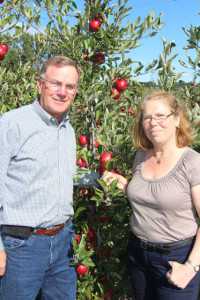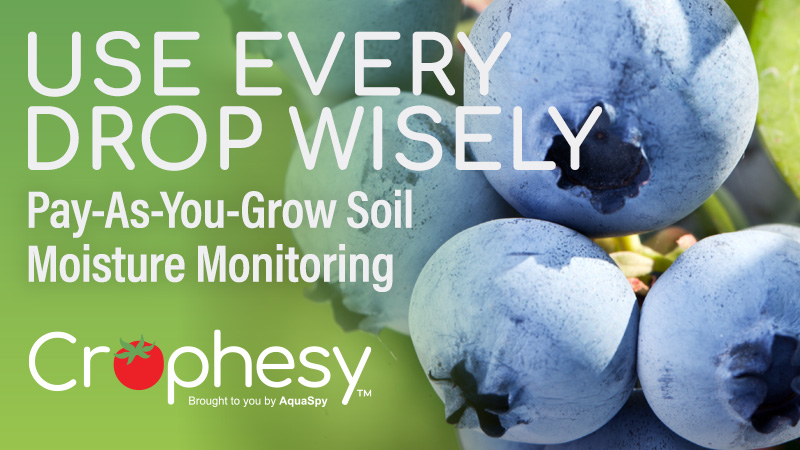New York Apples RubyFrost And SnapDragon Getting Closer To Market

John Teeple (Teeple Farms, Sodus, NY) and Susan Brown (Cornell University apple breeder)
For the past three years, New York apple consumers have been itching to get their hands on the two newest varieties developed by Cornell University’s apple breeding program. So, too, have the state’s apple growers, who last year began to see first-hand the potential they might have in the marketplace.
The wait is about over. This past summer, the apples received names that were surely a step up from NY1 and NY2, and a very limited supply of the fruit was available at a handful of farm retail operations. By next fall, there’s a chance they could begin taking up shelf space in some of the state’s supermarkets.
What We Learned In 2013
Despite the spring frost, last year gave growers some good intelligence on the characteristics and growth habits of the two varieties, according to Cornell apple breeder Susan Brown. Check out “The Lowdown On NY1 And NY2” to learn more about the features of NY1 and NY2.
This past year, Brown and others at Cornell were able to glean even more information. Through trials by Chris Watkins, a professor of postharvest science, they learned how the fruit responded to different temperatures during controlled atmosphere storage, and they also learned how it responded to SmartFresh applications. In addition, “we know more about vigor classifications, and we have a better handle on thinning requirements to optimize quality,” says Brown. “It’s easy to have more apples on a tree than might be good, so thinning guides are very useful in setting an optimized crop to maximize quality.”
Further trials are taking place in how the varieties respond to fertigation, including different fertilizer and irrigation rates. Leo Dominquez, a graduate student working under Cornell tree fruit specialist Terence Robinson, is conducting this research.
It’s All In The Name
The naming of the new varieties was due to the efforts of Cornell and New York Apple Growers (NYAG) LLC, the grower-developed organization tasked with licensing the varieties and contracting with grower members to manage acreage, packing, and marketing. NYAG worked with a group called Full Tilt Marketing, which then used feedback from a Cornell business class, consumer taste testing panels, and other means to come up with a short list of names.
The result of these efforts was SnapDragon™ (NY1) and RubyFrost™ (NY2). The names were revealed by Jeff Crist, vice chairman of the NYAG board of directors, at an annual Fruit Field Day at the New York State Agricultural Experiment Station in Geneva on Aug. 1.
SnapDragon was named because of the “snap” that comes from the crispness of NY1, says Brown. And dragon? “Kids like dragons, and we feel this will cause intrigue and make it a good variety to give to kids,” she says. The logo has a dragon, and it also has a tagline of “Monster Crunch.” SnapDragon gets its juicy crispness from its Honeycrisp parent, and it has a spicy-sweet flavor that was a big hit with taste testers.
When it comes to RubyFrost, Brown notes that NY2 has a very beautiful ruby red color early in the season. “The color and the attractiveness was the highlight. The frost was because of its juicy and refreshing taste. RubyFrost ripens later in the fall and stores well. Brown says she expects it will be popular with fans of Empire and Granny Smith.
Grower Feedback
John Teeple of Teeple Farms in Wolcott, NY, is one apple grower who already has RubyFrost and SnapDragon trees in the ground. He predicts both varieties will be a hit with consumers. “RubyFrost is easy to grow, it bears well on the tree, and the apples size well. It is also firm, which should make it easier to pack and ship,” says Teeple. “I think consumers will like it.”
Teeple is arguably even more excited about the potential of SnapDragon. “The bar has been set with Honeycrisp (one of SnapDragon’s parents), but I think this apple is better. It’s more grower friendly and branches well, and still has some of the same traits Honeycrisp has, as well as a unique flavor,” says Teeple. “It sizes nice, and produces a beautiful red apple.”
Brown notes that feedback from both growers and consumers has been encouraging. “We knew consumers who liked Honeycrisp would like SnapDragon, and the phone calls and emails we are getting support that,” says Brown. Demand from consumers took off even more after a story on the naming of the apples was picked up by the mass media. “After the report came out, we had people calling wanting to try it. It’s generated a lot of interest, and the fact we have a logo and tagline, plus good descriptions, has helped.”
Right now there are about 900 acres of the two varieties planted in New York, with a little more than half of that designated for SnapDragon.
Breeding For The Future
SnapDragon was a best-case scenario for getting a new cultivar from the breeding stage to the production stage, according to Brown. “It can take four years from planting seedling to having fruit. In the case of SnapDragon, as soon as we tasted the fruit, we decided to fast-track it and put it in test orchards at Cornell and on commercial farms,” she says. “You need a fairly high level of confidence to do this. If you put things out too early and they are dogs, you get a bad reaction from growers.” The reality in most cases, says Brown, is that you’ll have varieties that may look unappealing but have an excellent taste, or vice versa. In such situations, it’s important to evaluate growing conditions and fruit quality in several areas to determine the optimum location.
Brown also notes the overall importance of breeding programs to the apple industry. “A breeding program will look at different fruit components than other programs might not be able to do,” she says.
“Breeding programs are expensive, but we benefit from having access to plant pathologists, entomologists, postharvest experts, etc. It allows us to look in depth at certain facets of an apple’s performance. We can look at things way into the future, so we can have answers 20 years down the road.”
For growers concerned that they might not have access to these varieties and other “managed” types, Brown notes that future varieties may be open releases. “We are putting in patent applications for several different varieties. Some will be suited to wholesale, and others for retail,” she says.
“A few will be general releases, meaning anyone in the U.S. will have access to them, which I think
is important.”
The Lowdown On NY1 And NY2
Here’s a brief look at some of the notable features of Cornell’s newest varieties.
SnapDragon (NY1)
• Honeycrisp x advanced New York breeding selection cross
• Similar to Honeycrisp, but without leaf disorders and bitter pit
• Colors well
• Nice level of firmness and Brix
• Hangs well on tree
• Crisp, juicy, sweet flavor
RubyFrost (NY2)
• Braeburn x Autumncrisp hybrid
• Fruit hangs well and has good color
• Varying harvest maturity dates
• Firm, crisp, juicy
• Long shelflife
• Good resistance to flesh browning after cutting
[mmw-video id=”53844″]
What’s Next From Cornell
SnapDragon and RubyFrost may be the latest varieties coming out of Susan Brown’s breeding program at Cornell University, but they won’t be the last. Several potential releases are now in the evaluation stage, including a sour apple that Brown says she hopes might eventually become a hit with kids. There is no timetable on any of these cultivars, and the biggest question right now is how they might eventually be released. While SnapDragon and RubyFrost are currently limited to growers in New York, future varieties from Cornell might be open to anyone. “We see open releases as being crucial to helping growers stay competitive with new offerings if they are not in a state with a breeding program, or if they don’t have access to other ‘managed’ varieties,” says Brown.










